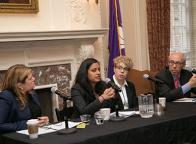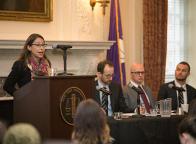One day after President Trump signed an executive order cutting off funding for locations known as "sanctuary cities," experts from NYU Law, media, and government gathered at the Law School to tackle key questions around the issue.
The event opened with introductory remarks by NYU Robert F. Wagner Graduate School of Public Service Dean Sherry Glied and Clayton Gillette, Max E. Greenberg Professor of Contract Law and director of the Marron Institute of Urban Management, and was divided into two panels. The first panel, composed of Alina Das ’05, associate professor of clinical law and co-director of the Immigrant Rights Clinic; Melissa Mark-Viverito, New York City Council speaker; and Dara Lind, journalist at Vox.com, explored what characterizes a sanctuary city and how such localities might respond to the executive order.
“The term ‘sanctuary city’ is a loaded term that means different things to different people,” Das said. Over the past 15 years, the federal government began relying on information from local law enforcement to prosecute those in violation of immigration laws. And while no jurisdiction in the US can prevent a person from being deported, Das explained, the places often described as sanctuary cities do not allow local law enforcement to assist with enforcing immigration laws.
Trump’s recent executive order targets jurisdictions that “willfully refuse to comply with 8 U.S.C. 1373,” a law prohibiting federal, state, and local officials from declining to provide information on immigration status requested by immigration authorities. Das noted that most sanctuary cities do not violate this law and have enacted provisions that are outside of it. For example, localities may refuse to share a person’s address.
Das argued that the executive order is “pretty clearly unconstitutional,” and pointed toward National Federation of Independent Business v. Sebelius, the 2012 US Supreme Court decision that upheld the Patient Protection and Affordable Care Act. The ruling demonstrated why, under the Tenth Amendment and the Constitution’s Spending Clause, the federal government cannot commandeer local resources to carry out its own regulatory scheme.
Mark-Viverito also criticized the executive order and urged elected officials to stand together against what she termed “ill-conceived plans” for immigration enforcement. “I’m proud that our city serves as a national model for those who wish to protect the rights of immigrants and immigrant communities,” she asserted.
In the second half of the program, panelists including Adam Cox, Robert A. Kindler Professor of Law, and Kate Brick, director of state and local initiatives at the Partnership for a New American Economy, discussed the myriad ways immigrants contribute at the state and local levels and the roles that cities and states might play in immigration policy during the Trump administration.
Over the course of the last century, Cox explained, state and local governments have had dwindling power to shape immigration policy. This is good, in his view, because constitutional law has evolved to disempower states from being able to make immigrants’ lives more difficult. For instance, local government cannot deny a free, public education to children who are undocumented.
On the other hand, he noted, there are also arguments in support of local policymaking around immigration issues, such as the claim that some cities may just be ahead of the times. Cox pointed to the California Trust Act, which prevents local jails from holding people for immigration purposes, as an example. Cox argued that states such as California are not uniquely situated to require different policies than other states. “Those states have an idea of what national policy should be,” said Cox, “and they’re using the instruments they have to organize change.”
Posted February 6, 2017

